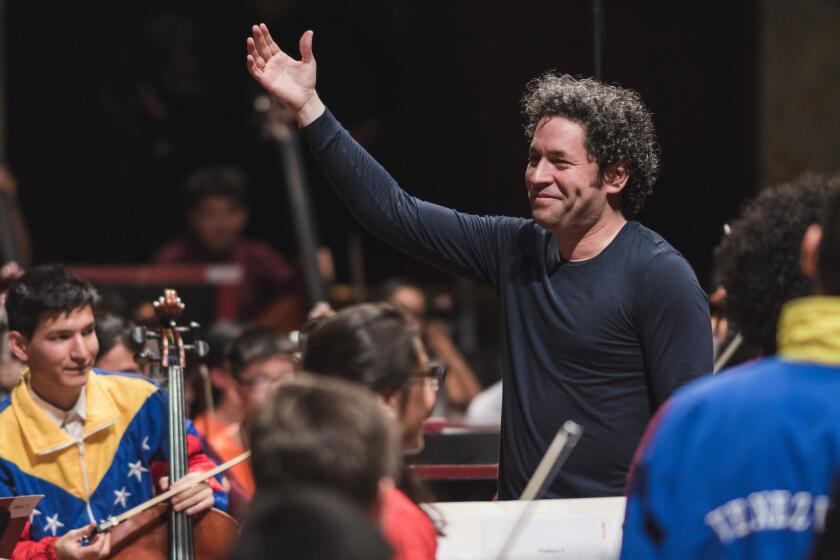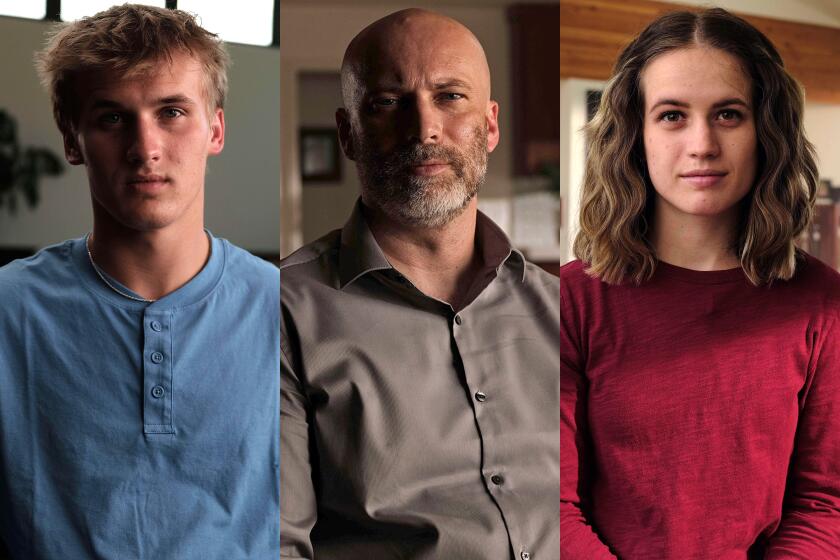Recycled as Artists’ Workshop : Old Fire Station Is Reborn
- Share via
First came the graffiti, scrawled by bold juveniles across the aging plaster of Los Angeles City Fire Station 18. Then, rain poured through holes in the roof onto the vacant interior, rotting the flooring and the joists. Vandals carted off what they wished.
So when artist Wendell Collins, 67, dragged an architect out to see the place a few years back, the reaction was predictable.
“Unless you’re Norton Simon,” the architect said, referring to the multimillionaire, “don’t fool with this building.”
But today, more than 80 years after it rose along the then-southern reaches of Los Angeles, long after it weathered the march of progress from horse-drawn engines to their motorized descendants, Fire Station 18 has been revived in an unusually cooperative recycling effort.
The city’s oldest fire station, it sports new gold and gray paint across its Mission Revival exterior. The original heavy wooden doors open onto an assortment of printmaking machines. Upstairs, the erstwhile living quarters for generations of firefighters have been transformed into a spacious display gallery and a cozy apartment.
With a bit of luck and an infusion of capital, Collins hopes to turn the former fire station into a printmaking workshop for young artists, particularly those from the surrounding largely black neighborhood where such art facilities are a rarity.
Fire Station 18’s survival was spurred by an alliance of preservationists, redevelopment agency officials, neighbors and Collins. And the parties are counting on the momentum from that mix to ensure the workshop’s future.
“People get excited when they hear of it,” said Melonee Blocker, who lives across the street and led a decade-long battle to refurbish the station. “I just hope that it’ll be a successful venture. It has all the potential of being one.”
Eighty-three years ago, when the Fire Department broke ground for its 18th station, the plot of land on Hobart Boulevard just south of Adams Boulevard marked the bare edge of Los Angeles--a distant five miles from downtown.
The department had become a paid operation only 18 years earlier. And the era’s primitive transportation led to some inventive approaches to firefighting. When a blaze broke out in the harbor area, horse-drawn fire trucks careened up to the Southern Pacific Railroad yard and boarded a flatcar, which trundled them down the tracks to the harbor.
Station 18, when it opened in 1906, was home to a steam engine--pulled by two horses--and a separate hose cart, pulled by a third steed. Four years later, it became one of the first stations in the city with motorized engines, according to Fire Department spokesman Vince Marzo.
But by 1968, Los Angeles had grown beyond Station 18, and the construction of new stations rendered it obsolete.
“We had a real concentration of fire stations in the downtown area, and it was not cost-effective to have that many,” Marzo said.
The oldest fire station still in service--No. 29 on Western Avenue--was built in 1913. Most of the early stations were torn down--many of them replaced by new stations on the same lot. Preservationists have sought to save many older structures, but with uneven success.
Collins first spotted Station 18 some time after it was vacated, while he was working as a journeyman commercial artist. He spent his career creating silk-screens, posters and display billboards for department stores, and also had occasionally taught young artists out of his home.
The fire station, he thought, would give him enough room to expand his teaching efforts. He sold the idea to the Thursday Night Group--fellow artists who have met with Collins one night a week for years. Several agreed to help out.
“I thought a fire station would be a good place,” he said. “I learned very early in my work . . . you need uncontested space. All the arts need space. That’s the bugaboo.”
In 1980, he began campaigning for the building in earnest. He called the Fire Department and unwittingly embarked on a six-year odyssey through the city’s bureaucracy.
“They sent me to the surplus buildings department,” he said. And that was only the start. “I went through 25 people in (different) offices. . . .”
Unbeknown to Collins, others were likewise agitating about the building’s future. Neighbors living in the Adams-Hobart area lobbied city officials--without success--in an effort to clean up the eyesore, which stood out amid the well-kept homes surrounding it.
“We always wanted it restored,” said neighbor Blocker. “From time to time they would say (restoration) will begin next year, or in June. . . . It took years. It’s all paper work and bureaucracy.”
And the Los Angeles Conservancy was similarly pushing for restoration because of the building’s history. Besides being the last firehouse built in the once-popular Mission Revival style, it was also the work of the late architect John Parkinson, one of Los Angeles’ preeminent designers.
Parkinson, in the years after he drew the plans for Station 18, went on to construct one of the city’s Art Deco masterpieces, Bullock’s Wilshire on Wilshire Boulevard, and also was co-designer of Los Angeles City Hall and Union Station, among others.
Ruthann Lehrer, director of the conservancy, said her organization began working with Collins after a surprise visit from the artist.
“He just came walking into our office and said he was really interested in the firehouse,” she said. The conservancy helped Collins connect with city officials. But Lehrer gives much of the credit for the building’s salvation to Bill Brown, the Community Redevelopment Agency’s project manager for the area that includes the station.
Before Brown took over his position in 1981, the Community Redevelopment Agency had agreed to tear the building down--but never had the money to do so, Brown said.
By 1982, prodded by Brown and the other parties, the Community Redevelopment Agency “saw the potential in the building,” despite its run-down state, Brown said. “I probably would have tried to buy it from the city myself if I could have,” he joked.
After the building’s background was documented, it was accepted on the National Register of Historic Places. A redevelopment bond issue provided $537,000 in restoration funds that were used to reconstruct the sagging supports and restore the damaged, 20-inch-thick walls.
Collins, meanwhile, had formally asked to lease the building as a site for a workshop offering apprenticeships to young artists interested in printmaking. Over the years, others had offered to transform the station into a senior citizens center, an apartment building or a personal residence, but Collins won out.
“All but Mr. Collins wanted to use it for their own personal use,” Brown said. “(His) proposal, which provided a community benefit, was more in keeping with what we saw. . . . It would be open to the public and get some use.”
The seven-month restoration was completed last September and Collins, who retired in 1984, moved into the upstairs caretaker’s apartment a short time later. Today the gallery upstairs is crowded with his books on history and literature, sculpture and prints, many of them recording the contributions of black Americans to U.S. history. Several of the prints are by Collins himself.
Plaques attesting to the station’s history are mounted on plaster walls outside, but inside there are few links to its past. The fire pole disappeared years ago--prompting endless unanswerable questions from visitors wondering where it went--and the only visible connection is an old fire extinguisher now doing duty as the base for a living room lamp.
Collins already holds some drawing and painting classes in the building--including meetings of the Thursday Night Group--while also working to get the printmaking operation in order. He also is seeking grants to cover the estimated $30,000 it will cost him yearly to maintain the building and pay for supplies.
Through private donations, his own savings and from Thursday Night Group members, Collins has acquired basic tools for lithography, silk-screening, photography and other endeavors. He has also begun searching for artists to act as teachers to his apprentices, whom he expects will come from school and Probation Department referrals and by word of mouth.
As he envisions it, eight to 12 apprentices could be attached to the workshop at any time, learning as their teachers’ schedules allow. While expertise in printmaking could provide the students with job skills, Collins is primarily interested in getting them involved as creative artists.
“Printmaking workshops are so rare,” he said. “Because of that, career choices and exposure are so limited. Printmaking is a stepchild to art, an industrial process. It’s also a process by which you can save souls, save lives.”
More to Read
The biggest entertainment stories
Get our big stories about Hollywood, film, television, music, arts, culture and more right in your inbox as soon as they publish.
You may occasionally receive promotional content from the Los Angeles Times.











